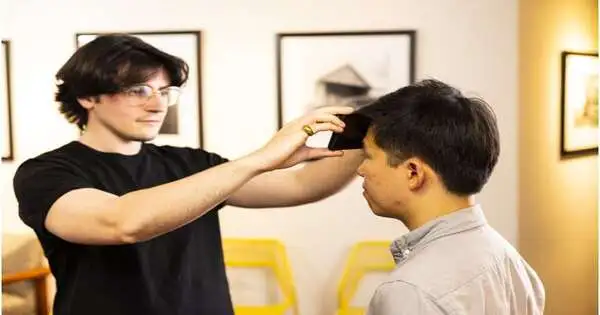You are not alone if you have ever considered taking a temperature but been unable to locate a thermometer. The most frequently cited COVID-19 symptom is a fever, which is also an early sign of many other viral infections. A temperature check can be very important for quick diagnoses and to prevent the spread of viruses. Despite the rise of telehealth consultations, precise at-home thermometers are still uncommon.
There are a couple of possible explanations behind that. The gadgets can cost anywhere from $15 to $300, and many people only use them occasionally throughout the year. The COVID-19 pandemic’s early days demonstrated how quickly thermometers sold out. It’s possible for a lot of people, especially those living in underserved areas, to be without an essential medical device when they need it most.
An app called FeverPhone, developed by researchers at the University of Washington, turns smartphones into thermometers without requiring additional hardware and is one solution to this problem. Instead, it collects data that is used by a machine learning model to estimate people’s core body temperatures by repurposing the battery temperature sensors and using the touchscreen on the phone.
“In a wave of influenza, for instance, people running to the ER can take five days, or even a week sometimes. So if people were to share fever results with public health agencies through the app, similar to how we signed up for COVID exposure warnings, this earlier sign could help us intervene much sooner.”
Dr. Mastafa Springston, a co-author on the study.
Fever Phone accurately estimated core body temperatures in comparison to some consumer thermometers when tested on 37 emergency department patients by the researchers. In Proceedings of the ACM on Interactive, Mobile, Wearable, and Ubiquitous Technologies on March 28, the team presented their findings.
Lead author Joseph Breda, a UW doctoral student in the Paul G. Allen School of Computer Science & Engineering, stated, “In undergrad, I was doing research in a lab where we wanted to show that you could use the temperature sensor in a smartphone to measure air temperature.” When I first arrived at the University of Washington, my advisor and I discussed how we might apply a similar strategy to health. We decided to use a simple method to measure fever. The fact that temperature is a difficult signal to measure is not the primary concern. Simply put, individuals lack thermometers.
The app is the first to use phone screens and sensors to figure out if someone has a fever. Breda stated that more training data is required for widespread use, but the technology’s potential for doctors is exciting.
“Every day, people come to the emergency room and say, “I think I was running a fever.”” “And that’s very different from saying, ‘I was running a fever.” Dr. Mastafa Springston, a co-author of the study and a clinical instructor at the UW School of Medicine’s Department of Emergency Medicine, said For instance, rushing to the emergency room can take five days or even a week during an influenza outbreak. Therefore, this earlier sign could assist us in intervening much sooner if individuals shared fever results with public health agencies through the app, similar to how we signed up for COVID exposure warnings.
Thermistors, or tiny sensors, are used in clinical-grade thermometers to estimate body temperature. Thermistors are also present in standard smartphones. Most of the time, they are used to keep an eye on the battery’s temperature. However, the UW researchers discovered that they could track heat transfer between a person and a phone with these sensors. The thermistors could measure the temperature of the air and the rise in temperature when the phone was touched by a body, and the touchscreen of the phone could detect contact between skin and phone.

A group led by scientists at the College of Washington has made an application called Fever Phone that turns cell phones into thermometers without adding new equipment. Joseph Breda, the lead author and a doctoral student at the Paul G. Allen School of Computer Science and Engineering at the University of Washington, is depicted here. Credit: Dennis Wise/University of Washington.
The team began testing this concept by collecting data in a laboratory. The researchers used a sous-vide machine to heat a water-filled plastic bag and pressed phone screens against the bag to simulate a warm forehead. The researchers looked at three different phone models in order to take into account a variety of factors, such as different people using different phones. They also changed the pressure on the phone and added accessories like a case and screen protector.
A machine learning model that used the intricate interactions to estimate body temperature was trained on the data from various test cases by the researchers. The app tracks how quickly the phone heats up and then uses touchscreen data to account for how much of that comes from a person touching it because the sensors are supposed to measure the battery heat. The researchers were able to calibrate the model to take into account variations in things like phone accessories as they added more test cases.
The team was now prepared to conduct user testing on the app. For a clinical trial, the researchers brought FeverPhone to the Emergency Department of the UW School of Medicine. There, they compared its temperature estimates to those of an oral thermometer. They sought out 37 participants, 16 of whom had a mild fever at the very least.
Participants held their phones like point-and-shoot cameras to use FeverPhone, with forefingers and thumbs touching the corner edges to prevent heat from being sensed from their hands (some had the researcher hold the phone for them). The researchers found that the optimal time for body heat to transfer to the phone was when participants pressed the touchscreen against their foreheads for about 90 seconds.
FeverPhone estimated patient core body temperatures with an average error of 0.41 degrees Fahrenheit (0.23 degrees Celsius), which is within the clinically acceptable range of 0.5 degrees Celsius. The researchers have identified a few areas that require additional research. According to the team, participants with severe fevers above 101.5 F (38.6 C) were not included in the study because these temperatures are easy to diagnose and sweaty skin tends to confuse other skin-contact thermometers. Additionally, only three phone models were tested with FeverPhone. The team stated that training it to run on other smartphones and smartwatches would increase its potential for public health applications.
Breda stated, “We started with smartphones because they’re everywhere and easy to get data from.” I am already investigating whether a smartwatch could provide a signal similar to that. Because watches are so much smaller, their temperature will change more quickly, which is nice. Therefore, you could imagine putting a Fitbit on a user’s forehead and measuring in ten seconds whether or not they have a fever.”
The paper was co-authored by Alex Mariakakis, an assistant professor in the computer science department at the University of Toronto, as well as senior author Shwetak Patel, an electrical and computer engineering professor at the University of Wisconsin.
More information: Joseph Breda et al, FeverPhone: Accessible Core-Body Temperature Sensing for Fever Monitoring Using Commodity Smartphones, Proceedings of the ACM on Interactive, Mobile, Wearable and Ubiquitous Technologies (2023). DOI: 10.1145/3580850





